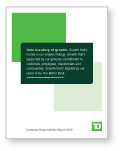Waste Management
-
- Waste Management
- Performance
-
We’re working to reduce waste from all of our major streams: paper waste, non-paper waste and e-waste.
The Story of Paper at TD
TD customers and employees are sending a clear message – use less paper. We are tackling this issue through all stages of the paper life cycle, from sourcing, through usage and disposal.
Sourcing
TD is committed to using environmentally certified paper (FSC, SRI, CSA) for letterhead, business envelopes, business cards and copy/fax paper. Our standard office paper contains 30% post-consumer content. Employees often ask why our standard is only 30% and not higher. Initial tests using higher mixes of recycled content resulted in more printer malfunctions and equipment maintenance.
Usage
While some bank account paperwork is required by law, there are many ways to reduce paper consumption. Where possible, we want to offer paperless options. To date, more than 8.9 million customers have chosen paperless record-keeping, saving 10,000 trees every year. We are also working to reduce our day-to-day paper use. During the summer, over 3,000 employees joined the TD Go Paperless Challenge to identify ways of reducing paper usage. Through this initiative, we received hundreds of ideas and gathered a panel of internal experts to discuss how we could put more paper-savings initiatives into action.
Disposal
In 2010, we announced participation in paper manufacturer Boise® Closed Loop System™, a recycling program to divert paper waste from landfills and reuse it in the production of recycled office paper.
How TD’s closed-loop recycling system works:
- Using the paper: As the consumer, TD purchases and uses paper.
- Protecting the information: The used paper goes through a confidential shred.
- Transport: The shredded paper is transported by a waste broker to a manufacturer of recycled content pulp, such as Boise.
- A second life: The pulp is used in the manufacturing process and turned back into paper by Boise.
- Closing the loop: TD purchases office paper.
The closed-loop recycling system will divert 1,500 metric tonnes of paper from landfills every year.
Non-Paper Waste
All locations in Canada are equipped with blue box recycling and some offices also offer facilities for organic waste. In 2010, we expanded our non-paper recycling program to all U.S. locations. In the first month of the program our recycling rate in TD Bank increased to 58%. We will continue to enhance the program in 2011.
E-Waste
E-waste includes our computers, printers, phones and other electronic equipment. As of the end of 2010, 98% of our e-waste is diverted from landfill. The majority is refurbished and donated to charities. All hardware components are recycled within North America. Our aim is that by the end of 2011, 100% of e-waste will be diverted from landfill.
-
2010 2009 2008 Recycling of computer components (tonnes) 92.6 60.0 49.3 Paper Paper usage (number of sheets) - Canada 420,637,500 421,848,000 420,965,000 Paper usage (number of sheets) - United States 226,778,000 262,987,250 Usage per employee - Canada 8,447 8,308 8,473 Usage per employee - United States 9,829 13,087 Usage per employee - North America 8,885 9,663
Overall TD’s paper usage of 8,885 sheets per employee is 12% below the industry average of 10,000 sheets per person. Usage in our Canadian operations (8,447 sheets per employee) is low by industry standards, but we have not been able to achieve significant reductions.
In 2010 we initiated a paper reduction program in our U.S. operations. We were able to achieve a 25% reduction from 13,087 sheets to 9,829 sheets per person.
To get below 8,000 sheets per person we will continue to make significant changes to our back-office processes and enhance our paperless record keeping options. In 2011 we will be assessing areas that can be prioritized for paper reduction.


